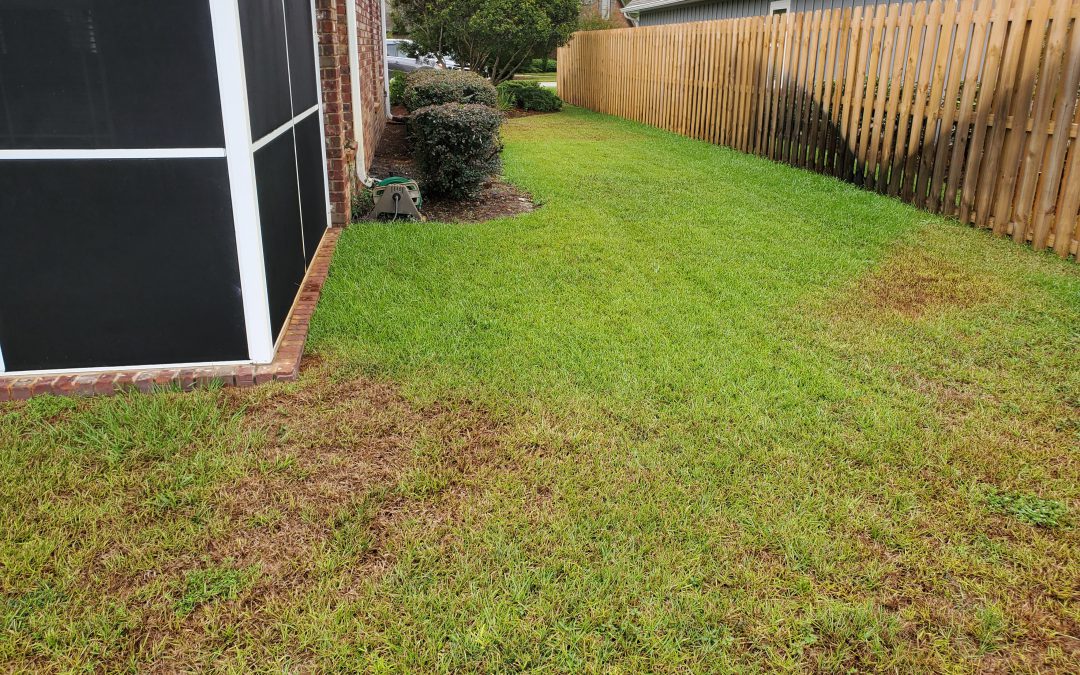
by Evan Anderson | May 13, 2020
As temperatures lean more toward summertime highs, conditions can sometimes leave a landscape looking sad. Water issues can be a major source of headaches for homeowners when they cause plants to decline. The cause is not always readily apparent.
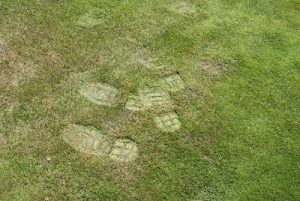
Footprints remain in droughty grass. Photo courtesy of Taylor Vandiver.
Water is something not even the meanest cactus in the driest desert can do without. Too little, and plants start to develop symptoms of drought stress. These symptoms include more than just wilting; stunted growth, curling or rolling leaves, fruit or leaves dropping, and yellowing or browning especially at leaf edges are all clues that a plant is thirsty. In lawns, underwatered grass may not spring back when stepped upon, leaving visible footprints in the turf. Long periods of drought stress can cause grass to thin. Plants exhibiting symptoms such as these may require extra water. A layer of mulch around landscaping can also help to retain moisture if soil dries out too quickly. Newly installed plants are particularly susceptible to drying out, and hot weather dries out all plants more quickly.
Plants can also be overwatered, however. Even with the well-drained, sandy soils that are present in much of the Florida Panhandle, it is possible to put too much water on a lawn or landscape. This can lead to problems that may be similar to those caused by underwatering – stunted growth, curled leaves, wilting, limbs or leaves dying, and increases in fungal disease can all occur. Lawns may become patchy and weeds, especially those that enjoy damp conditions such as sedges or dollarweed may establish themselves.

Improperly calibrated sprinklers. Photo courtesy of Evan Anderson.
Stress of any sort can also leave plants more susceptible to pest and disease issues. A healthy plant is better able to compete with weeds and fight off infestation or infection. If you notice problems with fungal disease, increased insect populations, or weed issues, it could be made worse by over- or underwatering!
To help avoid watering issues, make sure plants with similar water requirements are planted near one another. If you have irrigation for your lawn or landscape, it is important to calibrate it regularly. Make sure the system has a rainfall shutoff device and check systems for damaged or malfunctioning emitters. And remember, if you are having trouble with your lawn or landscape, contact your local Extension office for help!
You can find further information on watering in our EDIS publications located at https://edis.ifas.ufl.edu/topic_landscape_irrigation_and_fertilization, and at our Gardening Solutions website at https://gardeningsolutions.ifas.ufl.edu/care/irrigation/.
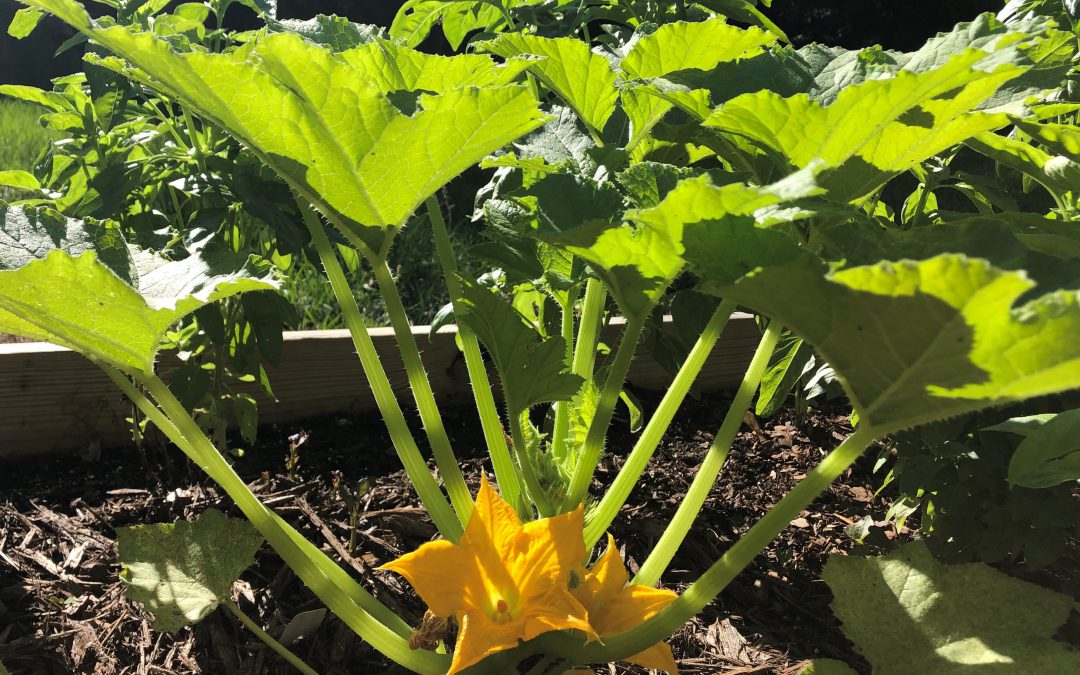
by Molly Jameson | May 7, 2020
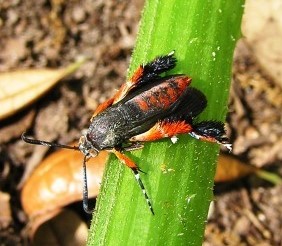
Adult squash vine borer moths are easy to identify, as they are reddish orange and have black dots along their upper abdomen. Photo by Theresa Friday.
It’s been a few weeks, and your squash seedlings are really starting to take off. The days are blushing with summer warmth and the flicker of lightning bugs in the evening indicates the cool nip of spring is winding down. In your garden, this has culminated in lengthening cucurbit stems that now show off a beautiful bright shade of green. Squash blossoms appear overnight and begin to expand and take shape, nestling themselves under the backdrop of slightly darker green squash leaves.
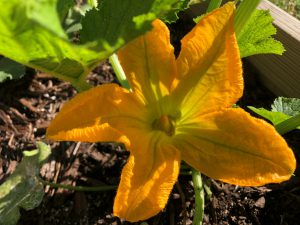
Black beauty zucchini blossom in the morning sun. Photo by Molly Jameson.
A few more nights go by, giving you a chance to explore some recipes. Maybe it’s time to fire up the grill and make grilled summer squash, sprinkled with fresh mint or thyme. Perhaps you’ll make a summer squash pesto pizza. Afterall, your basil is ready for its first harvest. If you are ahead of the game, you might even have some vine-ripening tomatoes that would pair nicely with squash in a creamy pasta sauce.
Your culinary dreams are running wild when you start to notice the wilt. You panic, and think you’ve forgotten to water the garden. But no, you’ve given your garden a consistent dose of water every morning. Your basil looks fine. Your tomatoes look great. What is going on?
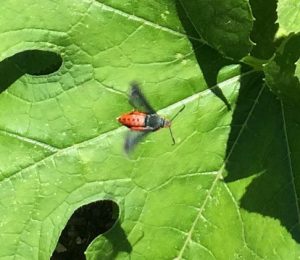
Squash vine borer adult in flight. Photo by Molly Jameson.
You have fallen prey to the dreaded squash vine borer (Melittia cucurbitae).
These garden pests rely strictly on plant species within the genus Cucurbita. If the squash vine borer didn’t wreak such havoc in your summer garden, you might find its striking red and black features fascinating. Unfortunately, if your squash plants are wilting unexpectedly, this daytime roaming moth may have already done its damage.
Adults lay single reddish-brown, millimeter-long eggs on the lower end of the main stem – or on leaves, leaf stalks, fruit buds, or in the soil near the squash plant. Within one to two weeks, larvae hatch, bore into the stem of healthy cucurbits, and begin to chew their way up. Multiple larvae can infect a single plant. This blocks the transport of water and nutrients, leading to the dreadful wilt that often signifies that it is too late.
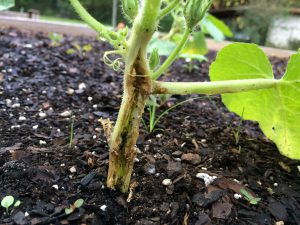
A squash plant severely damaged by squash vine borer larvae. Photo by Molly Jameson.
So, what can be done? Once the wilting has begun, you may be able to reap a small harvest, depending on the timing of infestation. Adult females emerge from cocoons from May to October in Florida and have two generations per season. They prefer cucurbit varieties with large tubular stems, such as yellow squash, zucchini, and pumpkins, but can also infest watermelon and cucumbers.
If you have some cucurbits that do not show signs of infestation but others that are on the decline, it might be worth removing and destroying the infested plants. At the end of the season, cultivate your soil one to two inches deep, as this is where they overwinter in cocoons. Destroying infested plants and cultivation can help reduce the overwintering population.
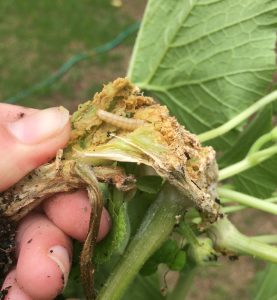
Squash vine borer larvae inside a squash stem. Photo by Molly Jameson.
In North Florida, try seeding squash indoors in March and plant seedlings in the garden in early April. The earlier you plant, the better chance you have of beating the borers. Of course, you must balance the risk of borers with the risk of a late frost.
You may also want to install lightweight floating row covers that can prevent the female from depositing her eggs. But again, it’s a delicate balance, as you do not want to prevent beneficial insects from pollinating your squash once it is producing blossoms.
Scout your plants diligently each day and keep on the lookout for eggs and adults. Adults are attracted to the color yellow, so yellow sticky traps or yellow bowls of water may lure them in. Build up the soil around developing plants to act as a shield against egg laying and boring.
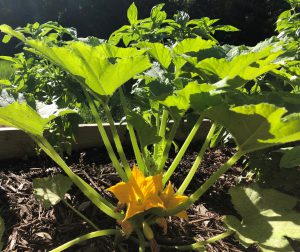
A healthy straightneck squash plant beginning to set fruit. Photo by Molly Jameson.
Once your plants slow their fruit production and you’ve had your fill of grilled squash, squash pizza, and creamy squash pasta, go ahead and remove the plants to prevent late infestations that can then overwinter. Lastly, rotate areas in which you plant cucurbits each year to break borer life cycles.
Vegetable gardening involves innovation and ingenuity. A clever gardener is always striving to balance weather, timing, insects, plants, soil, and everything in between. With a little planning and persistence, I know you can prevail against the tenacious squash vine borer.
For more information about squash vine borers, check out the UF/IFAS EDIS publication, Squash Vine Borer Melittia cucurbitae (https://edis.ifas.ufl.edu/in1068).
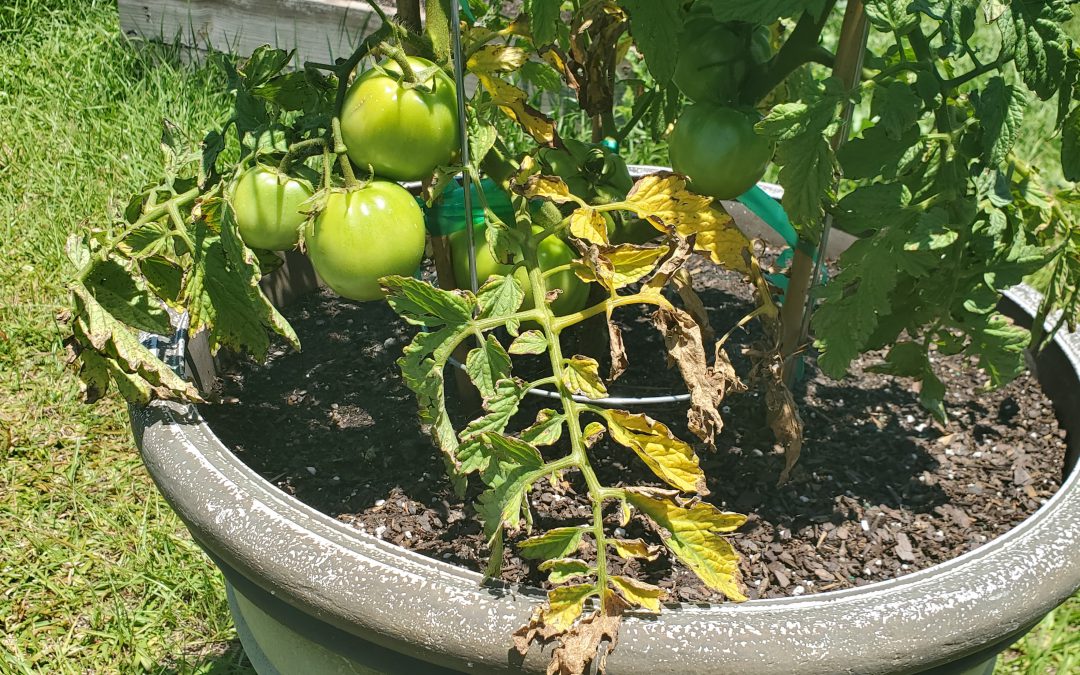
by Daniel J. Leonard | May 7, 2020
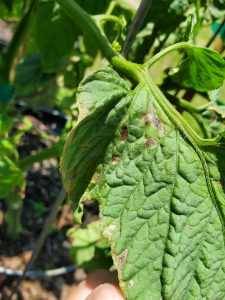
Early BLS symptoms appear on lower leaves. Photo courtesy of the author.
Tomatoes are among the most notoriously difficult vegetable species to grow in Florida. Even when you do everything right (choose disease resistant varieties, buy clean seed/healthy transplants, plant early, rotate crops, scout for insects, prune and support vines, etc), things can go wrong in a hurry. Bacterial Leaf Spot (BLS) caused by the pathogen Xanthomomas perforans, is one of those things. BLS often hitches a ride into gardens undetected on seed and transplants and presents itself as warm and humid weather arrives in late April/early May. Outbreaks typically happen in concurrence with the frequent heavy rainstorms that accompany these months and quickly wreak havoc on tomato plants.
BLS occurrence, much worse in some springs than others, has exploded this year in home gardens. First noticed on the plant’s lower leaves, BLS pathogens enter through natural openings in leaves called stomata, manifest as small, “water-soaked” leaf lesions and then develop within days into dark circular spots, sometimes surrounded by a yellow halo. As conditions worsen, all these individual infections cause a general yellowing or “blighting” of entire leaves. Though the issue begins on tomato leaves, BLS can affect all parts of the plant, including stems, flowers and fruit too! It’s at this point, when blighted leaves become obvious and lesion developing on flower stalks cause both flowers and small fruit to drop, that most home gardeners notice that something is up.
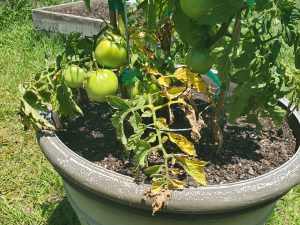
Advancing progression of BLS with “blighted” leaves. Photo courtesy of the author.
Unlike with many other pathogens, gardeners don’t have an abundance of options to control BLS. However, taking the following preventative measures can reduce the pathogen’s impact and stave off disease progression until ripe fruit can be harvested.
- Don’t irrigate overhead. Utilize drip/microirrigation or hand water beds and containers at soil level. This prevents the leaves from becoming wet; wet leaves become a perfect host for BLS.
- Never work tomato plants when leaves are wet. No staking, pruning, tying, or anything else until plant tissue is dry. Working wet tomato plants is an excellent way to spread bacteria!
- Sanitize pruning tools often and wash hands after working infected plants.
- Maintain airflow in plants by planting at correct spacing and thinning interior leaves as necessary to facilitate quicker drying of the plant.
- Prune lower leaves to at least 12” from the soil’s surface to prevent disease transmission from soil to leaves through splashing water.
- Remove infected leaves (when plants are dry!) to slow disease progression.
- Rotate crops and destroy infected plants to prevent buildup of BLS organisms in soil.
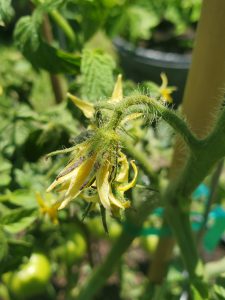
BLS lesions on tomato flowers. Photo courtesy of the author.
- Preventative measures are best, but if your garden has a history of BLS and local weather forecasts call for warm/wet/humid weather, it is best to spray fungicides proactively to protect your crop. A weekly spray with a tank mixture of copper and mancozeb is effective at keeping BLS at bay. This is the only chemical spray combination proven to be effective in controlling BLS.
- Unlike many common tomato pathogens that can be reliably avoided through planting resistant cultivars like ‘Big Beef’, ‘Celebrity’ and others, no varieties are resistant to BLS.
While BLS is an extremely destructive pathogen of both home and commercially grown tomatoes, growers can lessen the disease’s effects by following the preventative measures outlined above and spraying with a copper/mancozeb mix if necessary. Growing tomatoes this year hasn’t been easy, but it’s worth it to fight back and realize a harvest despite difficulties like BLS!
If bacteria have given you the blues or other garden issues are bringing you down, give your local UF/IFAS County Extension Agent a call! We’re here to help you be successful in all your horticultural endeavors. Happy gardening!
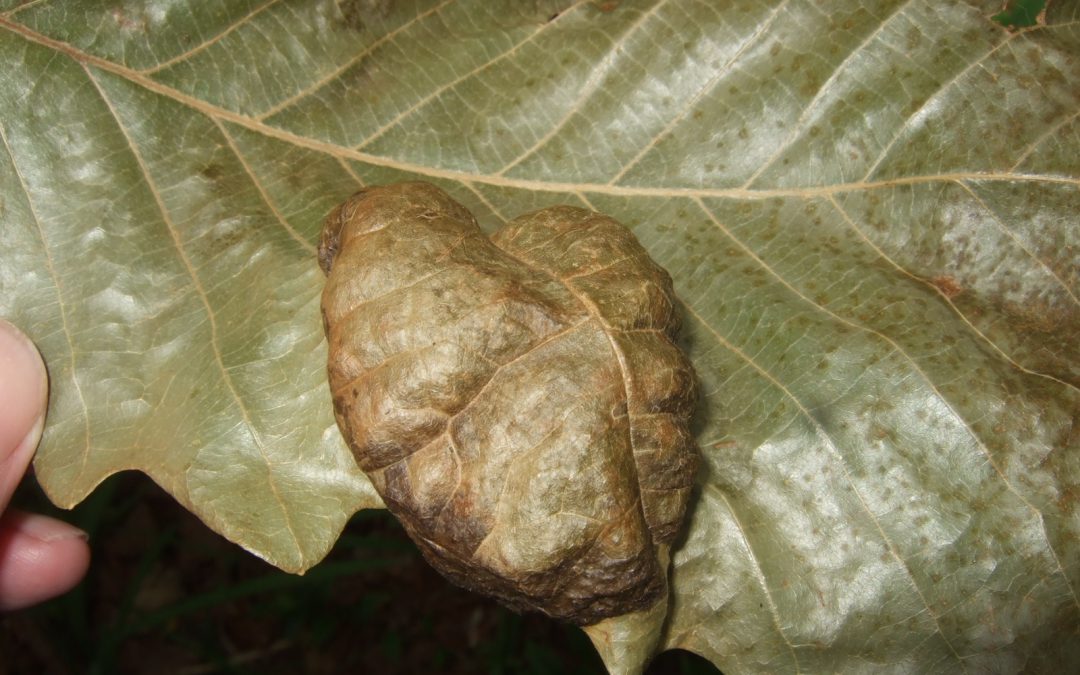
by Mark Tancig | Apr 30, 2020

Symptoms of oak leaf blister on swamp chestnut oak. Credit: Gordon Magill.
Even during global pandemics, it’s a joy to be outside during the great north Florida spring we’ve been experiencing lately. As cold fronts come through with their rain bands, some packing a punch, they leave behind the most pleasant mornings, clear blue daytime skies, and crisp evenings. Unfortunately, we’re not the only organism that also enjoys those cool days. Many species of fungi are quite active this type of year as the rains, followed by warmer, yet not too hot temperatures, create the perfect conditions for fungal growth. Some of these fungi grow right on or in the plants we’d like to be enjoying for ourselves, stealing nutrients and causing plant decline or merely causing aesthetic damage. As this is an active time for certain species of fungi, local extension offices are getting more calls and questions regarding lawn and landscape damage due to fungal pathogens. A recent call was a new one for me and an example of a native fungi-plant interaction that looks bad but requires no intervention from us. It also highlights how correctly identifying a disease leads to the best action and can often save time and money and prevent unnecessary pesticides (in this case a fungicide) from entering the environment.

Close up of oak leaf blister on swamp chestnut oak. Credit: Gordon Magill.
The fungi and plant involved here was the oak leaf blister (Taphrina caerulescens) on a swamp chestnut oak (Quercus michauxii). It forms, you guessed it, blisters on the leaves of any of the oaks, though live oak (Quercus virginiana), laurel oak (Quercus laurifolia), and water oak (Quercus nigra) seem to be preferred hosts. The spores of the fungi, dormant since the previous summer/fall and which happen to get lodged in bud scales through wind and rain, germinate in cool, wet weather. The fungus then infects young leaves as they flush and its growth causes a disruption in the leaves’ development. This leads to the blistered look of the leaf tissue and, during extended periods of cool, wet weather, the entire leaf sort of shrivels, browns, and eventually falls off. Spores are eventually released from the fallen leaves to start the process over the next spring.

Severe oak leaf blister on swamp chestnut oak. Credit: Gordon Magill.
Though the leaves look pretty terrible, this fungal disease rarely causes plant health issues and the tree recovers just fine. Specimen trees that experience it year to year may be treated with a fungicide, but most homeowners can just let it go. Raking up and disposing of the leaves may help prevent further infections by reducing the number of spores released in the area.
As you enjoy another cool morning after an evening rainstorm, remember that the fungi all around you are also having a great day. You may want to look at your landscape plants and see if there’s anything abnormal going on. If so, take a photo and send it to your local extension office for help with identification and best methods of control, or, like in this case, just leaving it alone.
p.s. As I said this was a new one for me and I want to thank Stan Rosenthal, Extension Agent emeritus, for assisting with identification.

by Daniel J. Leonard | Apr 29, 2020

‘Multipik’ fruit. Photo courtesy the author.
Never one to be satisfied growing “standard” vegetable varieties, last year I decided to peruse various seed sources in search of a superior yellow summer squash selection. Plain ‘Yellow Crookneck’ just wasn’t doing it for me anymore. After doing a little research and consulting a friend who works for Johnny’s Selected Seeds, I settled on a straightneck variety called ‘Multipik’.
Developed in the 1980’s by Harris Seed and now sold by many seed purveyors, ‘Multipik’ enjoyed immediate popularity with commercial squash growers due to its many outstanding qualities but curiously, is just making inroads with the home garden market. Even as it is set to celebrate its 30th anniversary next year, two years of personal experience with ‘Multipik’ verify several important characteristics making it a superior choice to many other traditional summer squash varieties: earliness/heavy yields and a precocious gene.

Newly developing ‘Multipik’ fruit. 4 weeks after planting. Photo courtesy the author.
The longer I garden, the more I’m convinced that earliness to maturity is directly related to yield potential in home gardens, especially in the Panhandle. Lots of varieties have high yield potential but that potential is often at least partially wasted here due to the length of time from seed to harvest. Ideally, you could plant, grow a crop and be done by mid-late June, before intense heat, humidity and all the wonderful garden pests and diseases arrive to destroy spring gardens. Maturing just 50 days from planting, ‘Multipik’ beats that deadline (when planted on time in late March) and yields heavily for at least a month before succumbing to the harsh Panhandle summer. Many traditional summer squash varieties, including ‘Yellow Crookneck’ mature 8-14 days later. While 8-14 days doesn’t sound like much, it can mean a major yield difference when factoring in the almost certain late season pests, diseases, and adverse weather conditions.
The next major advantage ‘Multipik’ offers is a precocious gene, meaning that it will mask symptoms and maintain its yellow color if infected with either Watermelon Mosaic Virus (WMV) or Cucumber Mosaic Virus (CMV), two destructive pathogens commonly affecting squash by discoloring fruit and reducing yield. This trait is critical to commercial growers because yellow squash that isn’t yellow isn’t marketable and is important to home gardeners too as a means to eke out higher yields under virus pressure. While the precocious gene isn’t a cure for either virus, it can help hold them at bay while you harvest! Another quirk caused by the precocious gene is the all-yellow appearance of the fruit, from the peduncle (the stalk holding the fruit to the plant) to the apex! From one end of the fruit to the other, Multipik ensures that when you plant yellow squash, you harvest yellow squash.

‘Multipik’ just days from harvest. Photo courtesy the author.
Whether you are trying to avoid yield loss from late season insect and disease pressure plaguing your traditional squash plantings or just want to try something a little different, I highly recommend planting ‘Multipik’ Squash. This early, disease-resistant cultivar with delicious medium sized, light yellow fruit is sure to be a hit in both in the garden and on the table. As always, if you have any questions about vegetable gardening or any other horticultural topic, give your local UF/IFAS County Extension Office a call! Happy gardening!

by Mary Salinas | Apr 29, 2020

Swarm of eastern subterranean termites. Photo by Susan Ellis, Bugwood.org.
Spring is in the air and that means termite swarming season is near!
Northwest Florida is home to fifteen native species of termites and six species that have invaded from other parts of the world. One invasive species of termite, the Formosan termite, arrived in the southeastern United States in the 1950’s and has been expanding its range and numbers ever since. While our native termites have colonies in the thousands of individuals, Formosan termite colonies can contain millions of individuals and that makes them a greater threat if they invade your home.
Here are some steps you can take to protect your home:
- Turn off outside lights during termite swarming season – late April through June – the swarms are attracted to the light and may then find entry into your home.
- Reduce moisture around your home by keeping gutters clean and having them drain at least a foot away from the foundation.
- Avoid irrigation hitting the house.
- Plants and mulch should be a foot away from the foundation.
- Repair leaks and cracks – termites can get into the smallest of spaces.
- Avoid wood, stucco and siding in contact with the ground.
- Have an annual inspection by a licensed pest control company. Read the fine print of what is covered and what species/type of termites are included. Some policies exclude coverage for Formosan termites.

For more information:
Subterranean Termites
The Facts About Termites and Mulch
UF/IFAS Featured Creature: Formosan Termites
Florida Department of Agriculture and Consumer Services Termite Control Information
Florida Department of Agriculture and Consumer Services Formosan Termite Program

























